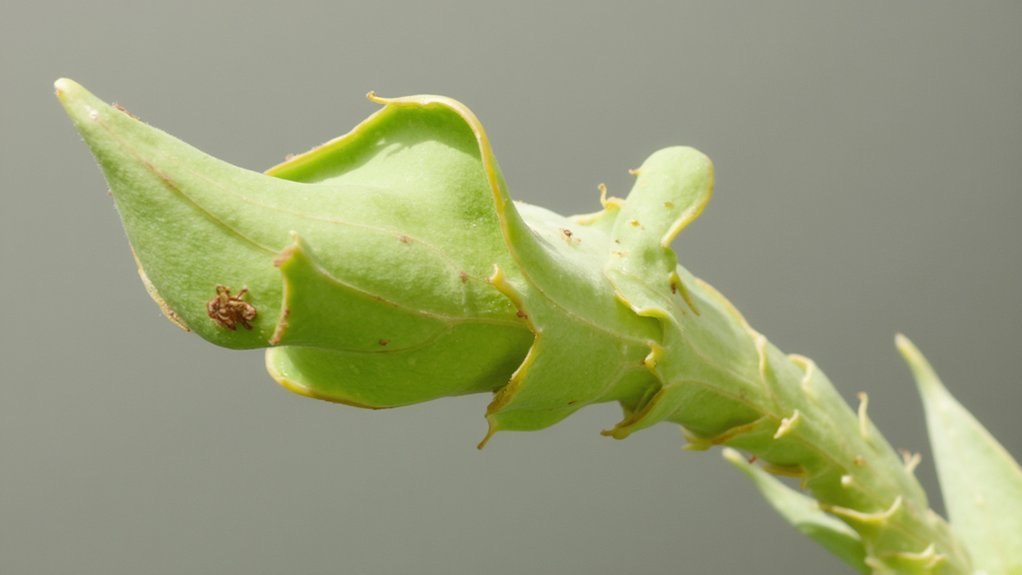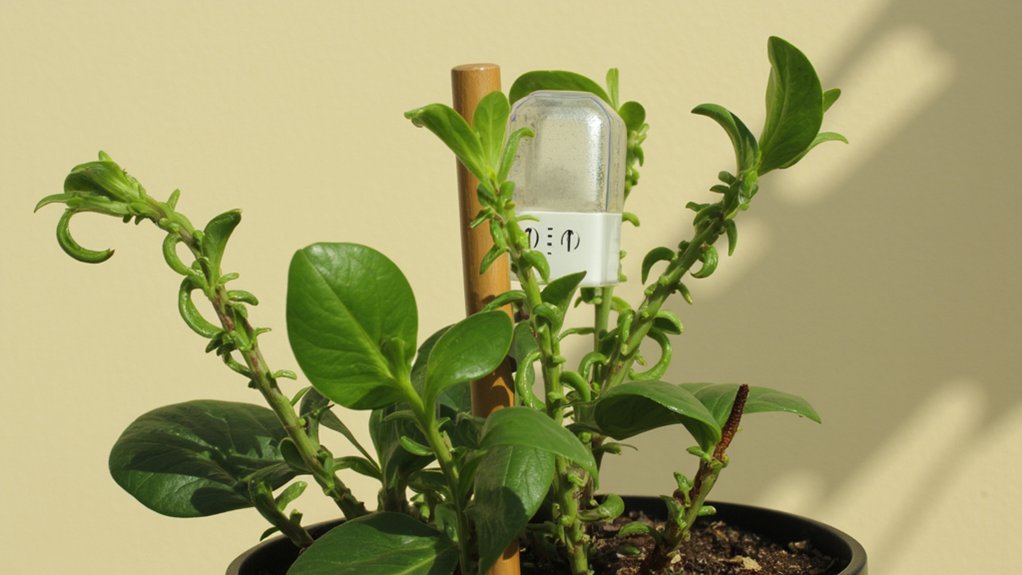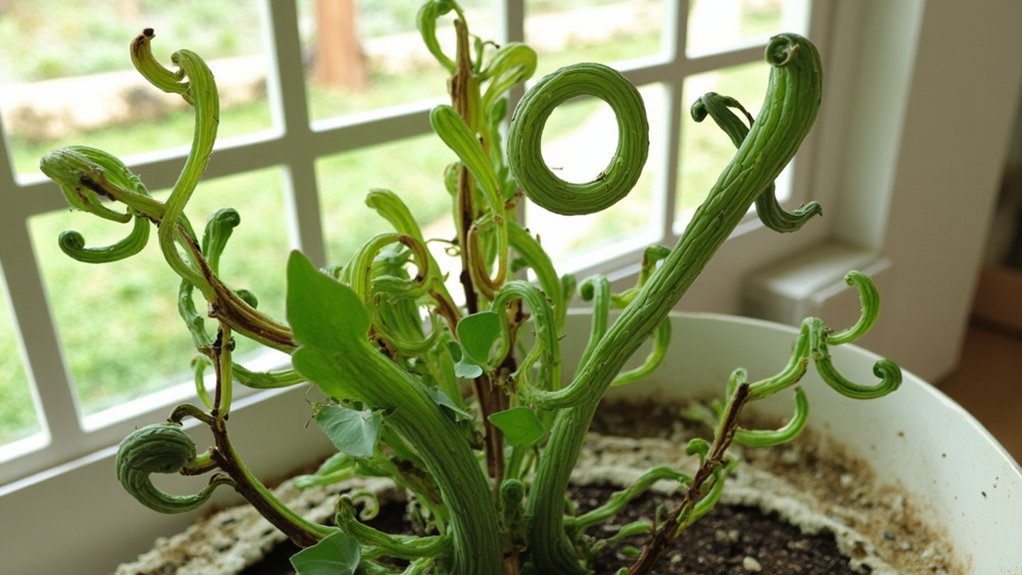Hey, when your plant’s leaves start looking a bit “under the weather,” don’t panic. Take a close peek at the undersides for tiny pests like spider mites, using a magnifying glass if needed. Then, check if the soil’s drier than a desert; water it evenly until the top inch feels moist. Curious about other sneaky causes? Stick around to uncover more fixes for those funky leaves.
Contents
Leaf Curling Diagnosis

How can you tell what’s wrong when your plant’s leaves start curling? Well, you’ve gotta play detective, and I’m here to help. Start by inspecting the leaves closely, looking for tiny pests like spider mites, which are smaller than a pinhead. Check under the leaves too, as they often hide there.
Next, consider the light exposure your plant’s getting. If it’s sitting in direct sun for over 6 hours daily, scorching might be the culprit, causing edges to curl inward. Move it to a spot with filtered light, ideally 4-5 feet from a south-facing window. Also, feel the soil’s top inch; if it’s bone dry after 3 days, there might be other issues at play. Keep observing daily for changes.
Watering Inconsistency

While diagnosing leaf curling, don’t overlook watering inconsistency as a sneaky culprit. Your plants can’t talk, but curled leaves might scream for a steady drink. Too much or too little water stresses roots, causing leaves to twist or droop.
Check your watering habits first, since inconsistency messes with plant health. Stick your finger 1-2 inches into the soil; if it’s bone-dry, water deeply until it drains from the pot’s bottom. If it’s soggy, hold off for a day or two. Set a schedule—water every 3-5 days, depending on your plant’s needs and room humidity.
Don’t guess; use a small moisture meter for accuracy. Adjust based on seasons, as plants often need less in cooler months. Keep it consistent, and you’ll see improvement fast.
Nutrient Deficiency

If your plant’s leaves are curling, a nutrient deficiency might be the hidden issue. You’ve gotta check for signs like yellowing edges or stunted growth. These often point to a lack of key stuff, like nitrogen or potassium.
Start by inspecting your soil’s condition; it might be lacking essentials. Grab a soil test kit from a garden store, and follow the instructions to get accurate results within a day or two. If nitrogen’s low, add a fertilizer with a high first number, like 20-10-10, applying 1 tablespoon per gallon of water every two weeks.
Don’t overdo it, though. Too much can burn roots, so measure carefully. Keep a log of applications, adjusting based on how your plant responds over the next month.
Pest Infestation

Let’s shift gears and talk about pests causing those curling leaves on your plant. You’ve gotta check for tiny culprits like aphids, spider mites, or whiteflies. These pests suck sap, distorting leaves fast, often within days.
Start by inspecting the undersides of leaves with a magnifying glass, if you’ve got one. Look for sticky residue, webbing, or small moving dots—spider mites are barely 0.5 mm long! If you spot them, don’t wait; act quick.
Mix a solution of 1 teaspoon dish soap with 1 quart of water, and spray it directly on affected areas. Repeat every 3-5 days for two weeks to break their life cycle. Keep a close eye, ‘cause pests can rebound if you’re not thorough.
Environmental Stress Factors

Beyond pests, environmental stress can also twist your plant’s leaves into curls. You’ve gotta check the conditions around your green buddy. Too much sun, or not enough, can cause curling fast.
Look at light first; direct rays for over 6 hours daily might scorch leaves, especially on hot days above 85°F. Move your plant to a spot with filtered light, ideally 4-6 hours of indirect sun. Next, check water—overwatering or underwatering stresses roots, so aim for soil that’s moist, not soggy, drying out 1-2 inches deep between waterings.
Temperature swings are sneaky culprits too. Keep your plant away from drafts or heaters, maintaining a steady 65-75°F range. Adjust these factors, and you’ll likely see those leaves flatten out soon.

While environmental stress can wreak havoc, viral leaf infections sneak in as another cause of curling leaves. You’ve gotta watch for signs like yellowing, stunted growth, or weirdly twisted foliage. These viruses often spread via insects, so aphids or whiteflies might be your culprits.
Check your plants daily for tiny pests, especially under leaves where they hide. If you spot them, act fast—use insecticidal soap, applying it every 5-7 days until they’re gone. Also, isolate infected plants immediately to stop the spread; a good 3-foot distance helps. Viruses can’t be cured, so prevention’s your best bet. Keep tools clean, washing them with a 10% bleach solution after each use, and always buy certified virus-free plants when possible.
Fungal Disease Impact

As you tackle the issue of curling leaves, don’t overlook the sneaky impact of fungal diseases. They’re tricky, often hiding under leaves or in damp spots, causing distortion and weird curling. Fungi like powdery mildew or leaf spot thrive in humid conditions, especially if air circulation’s poor.
Check your plants closely for white, powdery patches or dark, splotchy marks. If you spot these, act fast—remove affected leaves with clean scissors to stop the spread. Then, apply a fungicide, following the label for exact mixing, often 1 tablespoon per gallon of water.
Keep your garden tidy, too. Clear debris weekly, and water early in the day so leaves dry by evening. This cuts down fungal growth, keeping your plants healthier.
Herbicide Damage Effects

Let’s shift focus to another sneaky culprit behind curling leaves: herbicide damage. You might’ve sprayed weed killer nearby, and now your plants are suffering. Herbicides, especially those with glyphosate or 2,4-D, can drift on windy days, landing on innocent leaves. Within 48 hours, you’ll notice curling, yellowing, or distorted growth—yep, it’s a mess.
Here’s what you do: first, stop using herbicides near sensitive plants. If damage is done, flush the soil with water—about 1-2 inches deep—to dilute the chemical residue over 24 hours. Then, trim off the worst-affected leaves with clean shears to help recovery. Keep an eye out for new growth; it usually takes 2-3 weeks to see improvement. Stick to spot treatments next time, okay?
Genetic Plant Mutations

Ever notice your plant’s leaves curling in a way that just looks… off? Sometimes, it’s not pests or care issues, but genetic plant mutations causing the quirk. These are natural, internal changes in your plant’s DNA, altering how leaves grow.
You can’t “fix” a mutation, since it’s coded into the plant’s genes. Check if the curling appeared from the start, especially in new growth. If it’s consistent across the plant, not patchy, it’s likely genetic.
Don’t stress too much; many mutations don’t harm the plant’s health. Just monitor it for 2-3 weeks, noting if vigor drops. If it’s stable, let it be—your plant’s unique twist, like a quirky signature, might just grow on you!
Soil Ph Imbalance

Wondering if something else might be behind those curling leaves? Let’s talk about soil pH imbalance, a sneaky culprit. Your plant’s soil might be too acidic or alkaline, messing with nutrient uptake.
Grab a pH testing kit from a garden store, usually around $10-$15. Test your soil by mixing a small sample with water, following the kit’s instructions, and check the reading. Ideal pH for most plants is 6.0 to 7.0; if it’s off, you’ll see curling or yellowing leaves.
To fix it, add lime to raise pH if it’s below 6.0, or sulfur to lower it if above 7.0. Apply small amounts, about 1-2 tablespoons per gallon of soil, then retest after a week. Keep adjusting gradually until it’s right.
